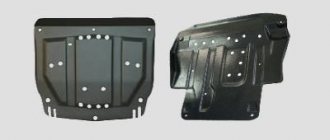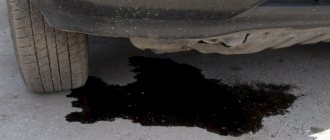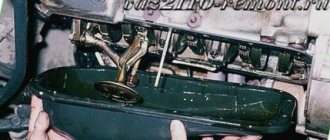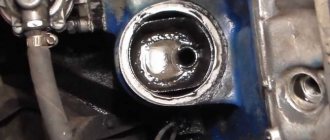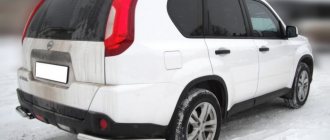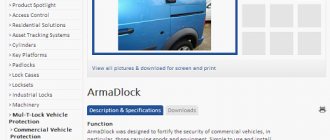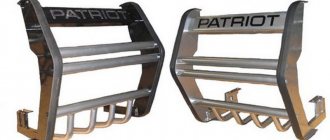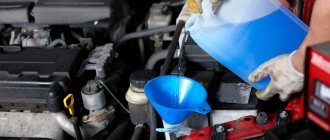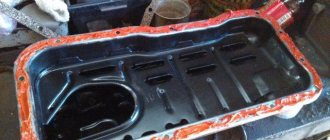Engine crankcase protection
The market offers a wide range of different protection options.
The market offers a wide range of different protection options.
Risk factor
The market for non-original additional equipment comes to the aid of owners who need complete protection of their units. It happens that for one car model there are as many as six different protection options available. The other side of the coin is that this equipment is not certified by the automakers themselves. At the official level, they say that the installation of such protections can affect the passive safety of the car in collisions and the temperature conditions under the hood. In the first case, human lives are at risk, and in the second, there is a risk of overheating and engine or gearbox failure. In this case, everything will depend on the specific car model, that is, its design features. For some, additional protection can play a significant negative role, for others - not.
In fact, the automakers are absolutely right, but the whole situation is governed by the word “may.” No one has conducted crash tests of cars with additional protection or any full-fledged studies on their effect on the operation of engines or gearboxes. In practice, there are no statistics that could confirm the negative impact of such additional equipment.
Crash test
Carrying out crash tests is an expensive proposition.
The cost of a full-fledged study of changes in the nature of damage with non-original crankcase protection and without it lies in a different plane. Carrying out crash tests is an expensive proposition. The cost of a full-fledged study of changes in the nature of damage with non-original crankcase protection and without it lies in a different plane.
In theory, additional protection certainly affects the distribution and absorption of impact energy throughout the power structure of the car and can lead to the fact that the engine will not be able to go under the car. However, no practical confirmation of this can be found in any body shop. There is also no consistent relationship that additional protection aggravates the consequences of an accident.
Non-standard engine crankcase protection, of course, affects the temperature regime under the hood, or more precisely, the aerodynamic air flows. Theoretically, its installation can worsen the cooling of the engine and gearbox. After all, its shape and location of the ventilation holes (if any) differ from the factory boot. However, in reality, there is no statistical evidence of possible harm on this issue. Failures of units due to overheating are mainly associated with their design flaws or malfunctions of the cooling system itself.
We will contact you shortly!
When it comes to protecting the oil pan, I remember several episodes from my driving biography.
Episode one - prehistoric
No one will argue that protection from below and the oil pan, and in general the entire engine compartment, is an arch-relevant issue for our Russian reality. It doesn’t matter whether you live in a metropolis, in a city with an average population, or in deep rural areas. And the outback in our wide open spaces is so diverse that sometimes, God forbid! In all my cars of those years, of course - domestic ones, starting with the Moskvich and downloading the “cherry-colored” VAZ-2108, the protection of the engine compartment was... a sheet of metal 3-4 mm thick with holes for fastening with standard bolts somewhere under the bottom.
Sometimes such sheets of metal even had special “hatches” for the oil sump drain plug, for the filter and for other service needs, so that when changing the oil, for example, there was no need to unscrew this entire metal sheet. How many engine crankcase pans and gearboxes have been saved by such metal “skis” can only be told by “running” mechanics. And sometimes these were indeed skis on which the “our mark” easily slid along gullies of the most varying complexity and regardless of the depth of the rut.
For myself, I designated the second episode as the “Renault stage”
And not only because the first “normal” foreign car I owned was a Megan Classic (the very first was a Ford Sierra without any engine protection). But because among the foreign manufacturers officially entering the Russian market at that time, it was these French cars that had metal (!) protection for the bottom of the engine compartment. Neither the Japanese nor the Koreans, nor the Mercedes and Opels at that time, if anyone remembers, were even equipped with mud-proof aprons. Sometimes you open the hood and see asphalt through the engine compartment.
By the way, some so-called engine compartment protections from many global manufacturers for third world markets still remain plastic. And they are honestly called “anthers”.
So, at the “second stage”, on a Renault Megan-2 car, I broke the oil pan and “cracked” the gearbox housing. It’s no wonder if, at a speed of about 50 kilometers, your belly collides with a reinforced concrete lamppost lying across a city street at night. The details are a different story, since now we are talking about protection, and the engine sump cracked precisely because the thickness of this very “branded” protection did not exceed one millimeter. Yes, the French were worried about us, but they also could not imagine that it was possible to run into such an obstacle within the city limits.
Third "protective" stage
And in my life, and in the lives of all other motorists in our country, it came when, in addition to foreign cars, some Western technologies “came to us.” It must be honestly said that the protections of that time made of fiberglass, soaked through with banal epoxy resin, and dried to the hardness of cement, were not exactly at the cutting edge of science and technology, but they still made a certain breakthrough in the protection market.
They were sculpted, exactly like that - sculpted (!), in homemade molds in private garages. Of course, they did not withstand any criticism in terms of aesthetics, and it was simply impossible to talk about any passive safety here, but they performed their function.
Progress, of course, does not stand still, including its garage version, which has grown from the personal boxes of enthusiasts and small businessmen into production workshops and industrial production. Homemade protections, fenders, doors, hoods and bumpers first appeared in domestic motorsport, and then became widespread.
I remember one story about such a “product”: a Daewoo Lanos with protection made of fiberglass impregnated with the same epoxy, at a speed of 35-40 km/h, the front end hits a cinder block, and this 25-kilogram building brick shatters into small fragments. In the next shot, the camera shows the viewer only a scratch on the “fiberglass” motor protection!
Why am I telling you this “car” biography of mine? And to the fact that today there is no need to rack your brains: should I screw a steel sheet on the bottom or buy normal protection “in place”?
Of course - buy it!
Why?
But because today it is no longer so expensive.
Impact protection
Official studies of all-wheel drive manufacturers and truck drivers indicate that from 10 to 35 percent of their customers, although they do not plan to do so, nevertheless systematically drive off the asphalt surface. And within the city itself there are curbs and shoulders, ice and winter tracks, as well as tram rails on which it is quite easy to cut a tire.
But the most terrible threat, and it is invisible, is barely covered or even “normally” closed sewer hatches, where one “ear” of the lid is broken off. The front wheel runs over such a cover, falls through, and the cast-iron hatch cover hits directly the engine crankcase or gearbox. Next comes oil on the asphalt, a tow truck and very expensive repairs.
Sound familiar?
And deep under the hood you can find the radiator of the cooling system, and the radiator with the air conditioning and power steering pumps, their lines, pulleys and drive belts, the exhaust manifold and the so-called exhaust system corrugation. This part, the corrugation, is not very complicated, not too expensive, but replacing it sometimes costs three times more than this spare part itself.
In cars with a classic layout with a longitudinal engine and gearbox, I saw protections that stretched from the front bumper and, in fact, to the rear axle, and with a transverse engine, both the engine oil pan and the gearbox housing are in the danger zone. And if you also have an automatic, then repairs can exceed the cost of the rest of the car. And such cases have happened.
In a word, if you think that you don’t need crankcase protection, then you are deeply mistaken.
Anti-theft protection
Not only does engine compartment protection make it possible to directly protect the engine, gearbox and other components from mechanical damage, but it also protects against water and dirt getting into the engine compartment. In addition, you won’t believe it, it also performs an anti-theft function. One day, an installer friend showed me how to steal a car “quickly” - from under the left fender, in the opening between the mud apron and the wheel, you can easily reach the ECU, the electronic engine control unit (we were, however, talking about a VAZ-2109 car). But even today, on some modern foreign cars, it is difficult to reach the alarm bell only if there is sump protection - after all, alarm installers try to hide the siren deeper in the engine compartment.
Security settings
There are only three of them, at least the ones you should pay attention to.
- Rigidity. It should ensure deformation only within the gaps between the protection sheet and the protected units and components (internal combustion engine crankcases and gearboxes). It is also desirable that the protection does not reduce ground clearance too significantly.
- Durability is understandable.
- Weight - it should not place a significant load on the front axle, and the optimal weight of the metal engine protection is usually considered to be within 7-12 kg.
Attachment points?
Yes, they must be checked and compared if you buy protection for a car yourself on the market or in a store, since most global manufacturers now have a lot of modifications to their models.
But if you order motor protection from Apollo Motors
, then don't worry! Your car will be delivered from the warehouse with exactly the protection that is made specifically for your car, your model and your modification.
What is the protection made of?
From a variety of materials: steel, stainless steel, aluminum, titanium and various composite materials.
Stainless steel
If with metal protection everything is relatively clear (this is, as a rule, steel-3), then with alloy steels it is both simpler and more complicated. We will not delve into the jungle of such a subject as “Metal Technology”, but will only say that the general public unites all alloy steels with one word - stainless steel. In terms of its characteristics, such protection is no different from ordinary steel, with the only difference being that its price is significantly higher, and it, of course, is not susceptible to corrosion.
Presentable appearance? Yes - it is there, but do you need it? If you really want to, then buy a regular steel protection and screw a decorative stainless steel plate on the front. Here you will have an attractive “pretentious” appearance, and not too expensive, without extra costs.
Aluminum protection
It is definitely much more expensive than steel, and its advantages include high rigidity with low weight, and a long service life.
Titanium
It is probably the best material for protecting the oil pan and combines all the advantages of many materials - high strength, corrosion resistance and low weight. Its most significant drawback is that it is very expensive.
So-called composites
For example, the same fiberglass that I talked about above consists of glass threads and polyester connecting them. Composite materials also include carbon fiber, carbon fiber, and Kevlar. These materials are increasingly being used in the mass automotive industry, and its specificity lies in the fact that it can take any shape, is quite strong and at the same time lightweight. Today, Formula 1 cars and sports cars of other racing series are made industrially from similar materials.
Composites have been used for many years in aircraft and shipbuilding, in astronautics and in the defense industry of virtually all developed countries. The composite is not subject to corrosion, it is “indifferent” to the “chemicals” that are sprinkled and watered on our roads in winter. And it has one more good property - it is an excellent “sound insulator”.
But if we talk specifically about carbon fiber or, for example, Kevlar, then their use is in no way justified from a financial point of view - it is too expensive!
At Apollo Motors
you will be offered a much more economical, but no less reliable option for crankcase protection for any car. You only need to state your personal wishes and listen to our manager.
Engine
Today, it is not engines, but automatic transmissions that are most sensitive to temperature conditions.
The gearboxes are packed with a large number of gears into very compact housings, a step that requires a high-performance cooling system. Today, it is not engines, but automatic transmissions that are most sensitive to temperature conditions. The gearboxes are packed with a large number of gears into very compact housings, a step that requires a high-performance cooling system.
The practice of official dealers, who themselves offer the installation of non-original protections, sometimes even several types, also plays against the position of automakers. It is difficult to imagine that in this situation the client would be denied warranty repair of units, the malfunction of which could theoretically be affected by the introduction of such additional equipment. Therefore, if you are afraid of possible problems, but you still need protection, but are running out of money, then buy and install on the side one of its types, which is offered by the dealer. In the event of a warranty claim, no one will look at where it was installed for you. Remember, the mere fact of having non-original protection is not a reason to refuse warranty repairs, for example, due to engine overheating. A cause-and-effect relationship still needs to be established.
On some car models, the standard boot is a solid sheet of plastic with scanty ventilation holes or no ventilation holes at all. In this case, installing metal or composite protection will not change the climate under the hood at all.
Dressing room
The market offers three types of crankcase guards: steel, aluminum and composite. At the same time, variations in shape and thickness are also possible for the same car.
Steel crankcase protection
Steel crankcase protection is the most popular product that has the most attractive price.
Steel crankcase protection is the most popular product that has the most attractive price.
The most budget-friendly are steel options. Unfortunately, they are heavy and provide the least protection. The degree of deformation is the most significant of the trio.
Owner reviews
If you have not yet decided which protection is better, perhaps reviews from car owners will help you make the right choice.
Composite protection
| Positive reviews | Negative reviews |
| Very light | High price |
| Easy to install | The holes were slightly shifted |
| Withstands hitting rocks |
Steel protection
| Positive reviews | Negative reviews |
| Low price | Started to rust |
| Takes hits well | Noise appeared after installation |
| Quick installation | Very heavy |
Composite engine protection
The fewer ribs a composite protection has, the higher its strength characteristics - tested on benches.
They are only additional voltage concentrators. Therefore, do not chase a beautiful appearance. The fewer ribs a composite protection has, the higher its strength characteristics - tested on benches. They are only additional voltage concentrators. Therefore, do not chase a beautiful appearance.
In approximately the same price range, which is almost twice the steel level, are aluminum and composite options. The latter type has the lowest weight with similar strength characteristics to the aluminum version. Unfortunately, under certain impacts, the composite material cracks and breaks down, and the protection will have to be thrown away. But the aluminum analogue can still be straightened and installed again.
Aluminum crankcase guard
Aluminum crankcase protection costs a lot of money.
But it is durable, lightweight and can be restored. Aluminum crankcase protection costs a lot of money. But it is durable, lightweight and can be restored.
Mounting options for different types of protection may differ significantly. Some can be removed and installed when changing the oil in a couple of minutes, while others will require much more time. All other things being equal, it is better to choose the option that will have the simplest and most reliable fasteners. This is where the experience of other owners will come to the rescue. Otherwise, you will have to constantly resort to intricate techniques when removing and installing, so as not to break soured fasteners, which can be extremely poorly positioned. Sometimes there are protections with technological windows under the drain plugs and the oil filter, but more often than not it is easier to dismantle such protection, so as not to have to wipe off the oil that has spread over it for a long time and persistently.
Photo: the author and “Behind the wheel”
Crankcase protection - choosing body armor for the engine
Device
The engine crankcase consists of two main parts - upper and lower. The upper part is integral with the cylinder block and is not subject to any external influences. The lower part of the crankcase, called the sump, is a completely different matter. This is a stamped structure made of relatively thin sheet steel, which plays the role of an oil reservoir. A sealing gasket is installed between the upper and lower parts, and they are connected to each other using bolts. There is a plug at the bottom of the crankcase for draining used oil. Even such a superficial description of this unit allows one to imagine all the consequences that may occur if the oil pan receives serious mechanical damage.
Engine diagram
